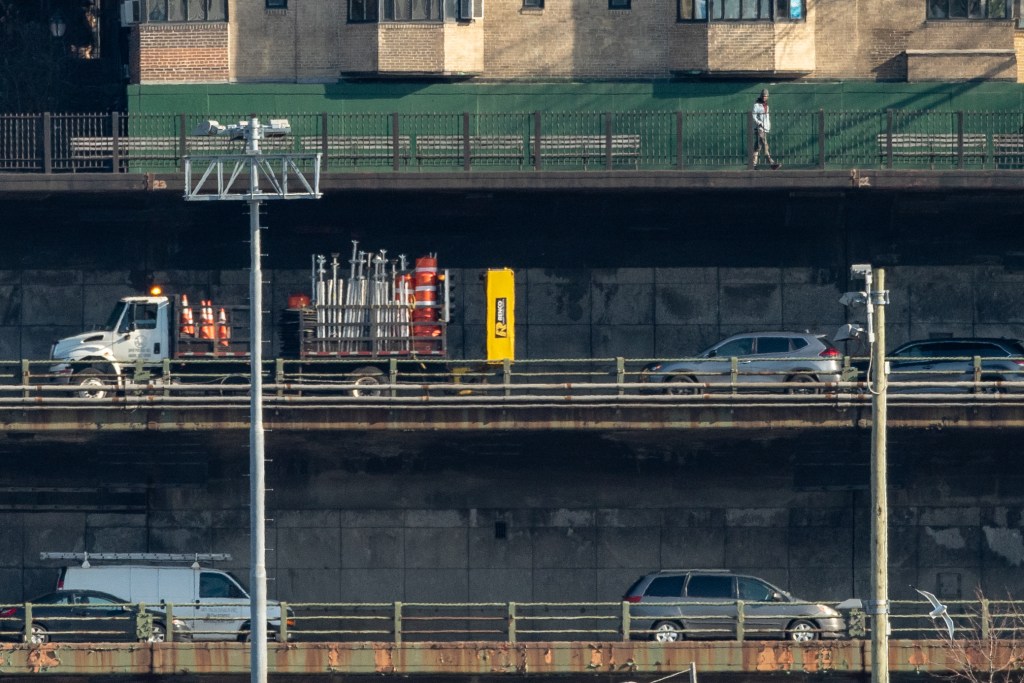On a sunny afternoon in April, members of the Brooklyn-Queens Expressway Environmental Justice Coalition stood, inhalers in hand, at the triangle where the BQE and Prospect Expressway converge, to call for a comprehensive, community-led plan centered on environmental justice for the entire roadway, from South Brooklyn to northern Queens.
The U.S. Department of Transportation had just rejected the city’s $800 million funding application to rebuild the notorious triple cantilevered section that runs through Brooklyn Heights. Rally attendees were hopeful that this news would catalyze the decades-long effort by organizations such as El Puente, UPROSE, Red Hook Initiative, and Brooklyn Heights Association, to focus on the health and safety of the people living in surrounding neighborhoods.
Sadly, in June the city released a new $5 billion plan that is a serious setback to that more inclusive approach. The latest plan outlines some modest engineering tweaks to the Brooklyn Heights section with the hope of extending its useful life. But the plan lacks a broader vision for the entire corridor.
We need to think big and go beyond merely shoring up the portion of highway that runs through the wealthiest zip code in Brooklyn. Inhalers are the visible reminders of the devastating impacts the BQE has had on Brooklyn and Queens communities over decades, as reflected in high asthma rates, a lack of street safety, and noise pollution.
For nearly 90 years, people in neighborhoods like Williamsburg, Red Hook, and Sunset Park have been living inside the vision — some might call it a nightmare — conceived by Robert Moses, which prioritized the movement of cars and trucks over the health and well-being of communities.
Now is the perfect time for residents living up and down the BQE corridor to finally have a say in what happens to the highway running through their neighborhoods. A community-led revisioning of the BQE might mirror major projects in Seoul, San Francisco, Seattle, and other cities that have reunited neighborhoods and sought to mend generations of environmental damage wrought by urban highways. Most recently, Rochester filled in the I-490 Inner Loop East trench, replacing it with affordable housing along a tree-lined boulevard.
Based on the experience in those cities, a new vision for the BQE might focus on physically reconnecting neighborhoods that were divided by the highway; prioritize expansion of mass transportation networks and safe pedestrian walkways and bike paths; and, invest in ecosystem repair and creating green spaces accessible to the most impacted communities.
Or, as in Rochester, a new vision might remove the highway altogether, significantly reducing carbon dioxide emissions and air pollution, which would be a big step towards reaching New York State’s goal of reducing greenhouse gas emissions by 40% by 2030 and 85% by 2050.
In 2020, an expert panel recommended re-envisioning the highway and restricting truck traffic along the corridor. Combined with NYC’s recently announced plan to expand the Brooklyn Marine Terminal to shift freight service towards the “blue highway,” reducing truck traffic could be a catalyst for communities to re-imagine their relationship with the BQE.
There is no doubt that the Brooklyn Heights section of the BQE is in desperate need of rehabilitation: recent estimates say it could be unsafe as soon as 2026 without a complete overhaul. But there are disturbing signs of deterioration and distress throughout the length of the highway. The entire highway is aging, and it is only a matter of time before other segments also need urgent repairs.
Brooklyn and Queens residents should take the lead in envisioning a new future for the BQE. Elected leaders must support this effort by insisting that city, state, and federal DOT officials work together to fully explore all possibilities for this critical project. We should imagine a post-BQE future where we aren’t being poisoned by the exhaust from thousands of idling trucks and cars, where communities are reconnected, and where hundreds of acres of land can be returned for use as new green space or affordable housing.
New Yorkers deserve the opportunity to imagine a better future that will finally clear the air around the BQE.
Goldstein is president of the Municipal Art Society of New York and was a member of the city’s panel which issued a report on the future of the BQE in 2020. Fink is an architect and executive director of the Institute for Public Architecture, which is producing “The Story of the BQE,” a film and oral history project.
